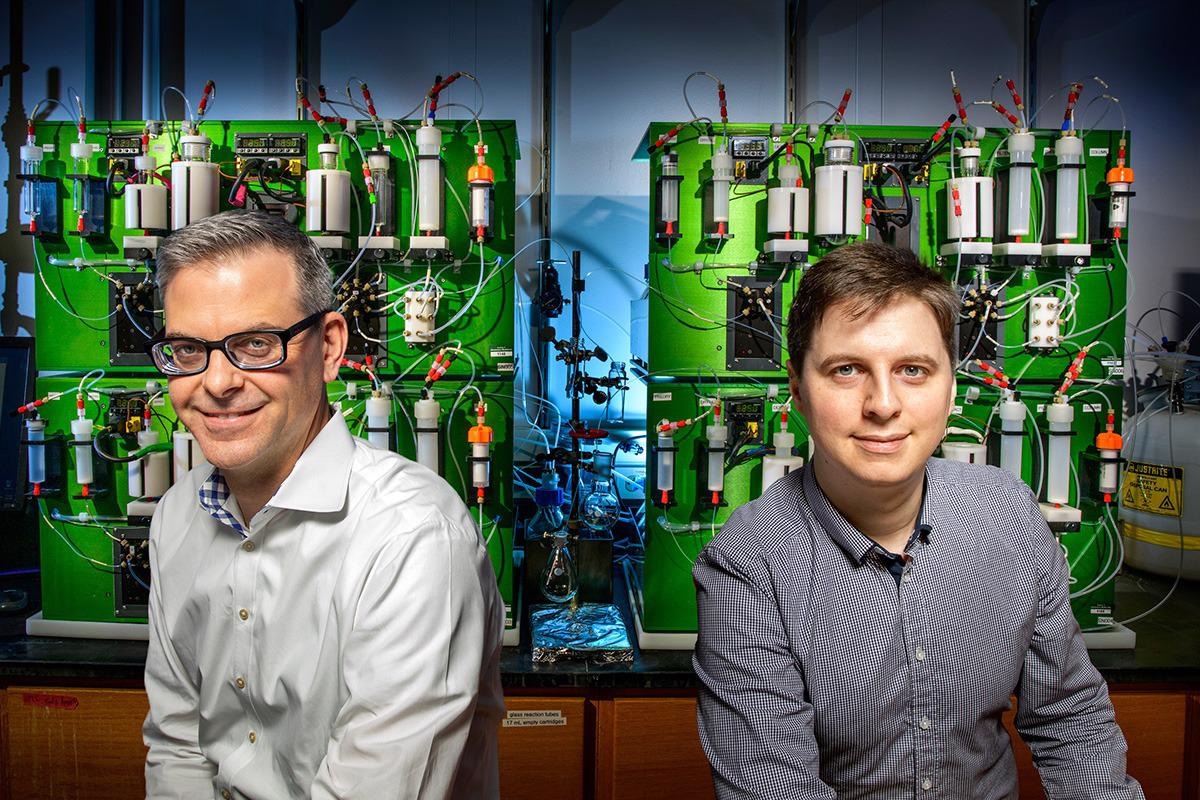A newly developed set of molecular building blocks aims to turn complex chemistry into something as simple and accessible as a toy construction kit.
 University of Illinois chemistry professor Martin D. Burke, left, and postdoctoral researcher Daniel J. Blair developed a new class of chemical building blocks and a next-generation molecule-making machine to assemble them into complex small molecules with 3D twists and turns. (Image Credit: Fred Zwicky).
University of Illinois chemistry professor Martin D. Burke, left, and postdoctoral researcher Daniel J. Blair developed a new class of chemical building blocks and a next-generation molecule-making machine to assemble them into complex small molecules with 3D twists and turns. (Image Credit: Fred Zwicky).
Scientists at the University of Illinois Urbana-Champaign and partners at Revolution Medicines Inc. created a new group of chemical building blocks that just snap together to develop three-dimensional (3D) molecules with intricate twists and turns, and an automated machine to arrange the blocks like a 3D printer for molecules.
This automation would enable chemists as well as non-chemists to produce new materials, catalysts, pharmaceuticals, diagnostic probes, sweeteners, perfumes, and more, said study leader Dr. Martin D. Burke, a professor of chemistry at Illinois and a member of the Carle Illinois College of Medicine, as well as a medical doctor.
The scientists reported their results in the journal Nature.
It makes very complex 3D molecules in a very simple way. This has been the secret chamber that only card-carrying chemists with decades of experience can enter. This new advance blows that door wide open. Now everyone can come in and play in the sandbox, because these very complex molecules become very accessible.
Dr Martin D. Burke, Professor of Chemistry, University of Illinois Urbana-Champaign
For over 15 years, Burke’s group has pioneered the advance of basic chemical building blocks known as MIDA boronates, which snap together in sequence using a single simple reaction to form small molecules.
His lab and partners at Revolution Medicines built a molecule-producing machine that automates chemical synthesis using these building blocks. However, the MIDA blocks are basically confined to forming flat, 2D molecules.
The new group of building blocks, known as TIDA boronates, unravels the missing third dimension, integrating specific twists and 3D structures straight into the blocks.
It’s all about function. Three dimensionality equals function. The first generation was like those square and rectangular children’s bricks that can click together to build a nice, simple toy house. These are like the cool, complex brick kits for adults that let you build the Batmobile.
Dr Martin D. Burke, Professor of Chemistry, University of Illinois Urbana-Champaign
To showcase the ability of the TIDA blocks and the new second-generation molecule-producing machine, the team synthesized two antimicrobial natural products with particular 3D features including a cyclical structure, as well as a collection of smaller representative structures present in various types of molecules.
Nature is very good at making three-dimensional things in a very precise way. A lot of the molecules we use as inspiration for making many of our medicines are natural products, and those with these 3D structures tend to perform better in clinical applications. Yet until this point, it has been very difficult to capture these structures within modular building blocks. The whole goal is to help more people make more molecules as simply as possible.
Daniel J. Blair, Postdoctoral Researcher and Study First Co-Corresponding Author, University of Illinois Urbana-Champaign
The building-block method to forming molecules holds a number of benefits for chemists and non-chemists alike, the scientists said. Normally, chemists use a lot of time and struggle to create a single target molecule, Blair said.
Three-dimensionality hampers the preparation of different derivatives of a molecule to explore its function. By capturing a lot of that three-dimensionality up front in modular building blocks, we can easily construct a target molecule. Next, we can exchange single building blocks to directly access derivatives and then see how that affects molecular functions.
Daniel J. Blair, Postdoctoral Researcher and Study First Co-Corresponding Author, University of Illinois Urbana-Champaign
Besides including more function, TIDA boronate building blocks are up to 1,000 times more stable than MIDA boronate blocks in crucial reaction settings. They are also very stable in water, allowing the routine synthesis of even more categories of chemicals under a broader array of conditions.
“MIDA had this loose spot where the connector piece was. When we switched to TIDA, that connector part twisted like a screw, and it's like tightening down a bolt and a nut. And now it's surprisingly stable,” Burke said.
The scientists are aiming to expand the library of TIDA boronate building blocks and hope to make them as extensively commercially available as possible, using the success of MIDA boronates as a protocol.
MIDA boronates are currently extensively used: Approximately 270 are available in the market and over 250 academic and industrial labs have employed them to make discoveries resulting in over 750 publications and 200 patent applications, Burke stated.
“One of the things we’re so excited about now is we can make molecular building kits for really complex molecules. Like a plastic block, kit has all the specialized pieces and you snap them together, now we can imagine kits for complex, important molecules, and make them accessible to nonchemists. I think it’s a chance for us to shatter some of those barriers that have traditionally limited who gets to innovate at the molecular scale.”
This work was supported by the National Institutes of Health, the National Science Foundation, the Damon-Runyon Cancer Research Foundation, the Henry Luce Foundation, the ACS Division of Organic Chemistry, and the Austrian Science Fund.
The University of Illinois has filed patent applications for both TIDA and MIDA boronates. Burke is a founder, consultant, and shareholder for Revolution Medicines Inc., which offered extra support for this study in the form of the TIDA reagent.
Journal Reference:
Blair, D. J., et al. (2022) Automated iterative Csp3-C bond formation. Nature. doi.org/10.1038/s41586-022-04491-w.